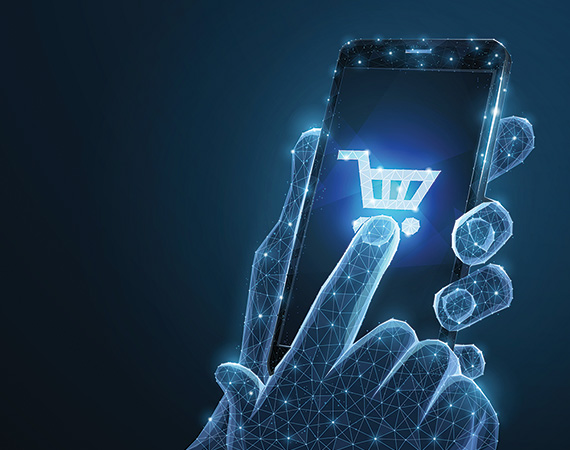The past year has seen massive changes in how businesses communicate and connect with customers. Statistics from a recent McKinsey article highlight the dramatic way businesses and customers relate to each other and how changing habits altered the landscape — in some cases permanently. For example, the article states that only 20% of businesses hope to return to in-person selling. What that means to me — and what makes that important for your business and communicating to your customers — is that 80% of business-to-business buyers now prefer a digital or self-service sales transaction.

This change of buying and selling mindset warrants a change in the approach businesses communicate and sell their product — or service — without diminishing the effectiveness of the communication and selling process.
I strongly believe this change has resulted in a fundamental shift in the way that we do business both now, today, and in the future, regardless of the status of the pandemic. It is a universal takeaway every business can use to fuel future revenue growth.
Changing strategy without changing core values
In order to continue on a positive profitability and growth trajectory, it is important to build on and maintain the core principles that haven’t changed. By working through those foundational pieces to profitable growth, there are practical steps to help you think through how to identify and define them for your business. Doing so helps leverage them for profitable growth now and in the future.
The important keys worth sharing with you revolve around:
- Identifying the right customer.
- Defining the right message.
- Delivering the right value.
Even though the way we connect with our customers has changed, the foundational keys to profitable growth have not changed.
The identifying factors above can be described as knowing and identifying the right customer, defining the right message that resonates with those customers, and delivering value — the right value. I can’t overemphasize the role that value plays and how integrated this concept of value is in relationship with customer message and the value delivered.
When we discuss the relationship between customers and how to influence the choices they make, it’s imperative to talk about how value permeates that relationship and some of those choices. There’s a foundational relationship between three entities: your company, the customer, and the competition.
There is a continual dynamic relationship happening between all three of those entities. What really holds them together and what connects them all is value — value delivered and value received. We want to think about and consider value received — specifically the perception of value received and more importantly, the customer’s perception of value received. That perception of value really drives and influences all of these relationships.
Building a perception of value
The first step is understanding who your customers are, what they care about, the kind of things that they value, and how they perceive and define value. Next, create and deliver value that aligns and matches it. A successful business leverages value — defined as benefit less cost — for profitable growth. When thinking about customers, their perception of value should far outweigh that same level of cost — whether it’s financial commitment, time opportunity costs, or other factors. The better we are as business leaders at understanding our customer’s perspective around value, the more likely we are to be able to leverage that knowledge and insight and help to utilize it and grow profitably with our businesses.
Focus on the customer
In order to properly identify value, it’s important to start out defining who the target customers are, where they are, what they need, and what they care about. The better a business leader understands those things, the more likely the business is to yield positive results in growth and also positive sales efforts.
Who is the target customer? Customers who:
- Help us to maximize our capabilities to get the most out of our business.
- Value what we do, our products or services, and/or who we are and why we exist.
Customers help us maximize capabilities, whether that equates to maximizing workflow, output, or the way a facility is set up, which also helps them maximize the value that they provide to the clients. It can also mean developing strategies to start engaging in social media and creating blog posts and writing and putting these posts out to the universe on a regular basis. Many companies publishing posts write stories about who they are, their products, their services, their capabilities, and the kind of value that they provide to the marketplace. It can help gain traction, build an audience and build interest on a human level.
As a first step, it helps to develop a profile of our target customers. I like to build profiles that include demographic (who they are), geographic (where they are), and psychographic (how do they think) characteristics. Once the profile is defined, it can be used to begin quantifying the opportunity that exists with that target by applying it as a filter within any number of business databases. Hoovers is a good example of a strong database or business listing. Once we have a list of businesses that match our target customer profile, we can make some assumptions about average revenues to quantify the potential of the market. But before we get too far, let’s dig further into the development of the target customer profile.
Target customer profile
We oftentimes go through this process with our clients by using a tool that we call the most valuable customer analysis. It’s basically a process of using the information we know about some of our existing customers to define who we want to target. We can then use this information to create the profiles we’ve been talking about. Here are some things to think about as you identify the characteristics of each profile you develop. Remember, it is easiest to start by thinking about one of your favorite customers.
Demographic
Think about demographics as a kind of census-type data and look for common characteristics. Try asking the following questions:
- What industry do we want to target?
- What type of business are they in? (e.g., OEM, reselling, manufacturing, etc.)
- What size of business are they from a revenue standpoint or from an employee standpoint?
- What is the ownership model? (e.g., private, partnership, public, equity firm, etc.)
An important characteristic to identify is the job title of the target contact, the decision maker, or the ideal person who you would work with at that business.
Geographic
Think about geographic characteristics in a few different ways. Oftentimes we think locally, and we think about radius distance around our business. The radius could be 25 miles, 200 miles or it could be something else. We can also think about this from a regional perspective. Maybe it involves looking at the entire United States divided into its regions: the Northeast, the Southwest, etc. Maybe it involves looking nationally versus internationally. Geographics could also involve a sales team that has different sales territories, so we think about it from a territorial perspective. Consider how logistics might impact the size of the sales territory and the distance from which you can effectively sell or provide goods or services. Consider the size and weight of the product for transportation purposes. In the end, what geographic region are you targeting?
Psychographic
Think about psychographic characteristics as the needs, cares, and things that the target customer values. It’s about how customers think and behave, which is really a reflection of the culture at their business.
What are the things customers care about or need? It could be things they appreciate from their suppliers. It could be benefits they’re seeking to gain from their suppliers, or maybe it’s those issues or challenges that they’re currently struggling with, or that they’ve faced in the past.
Analyzing psychographic characteristics is probably the most challenging. It requires the deepest level of thinking about our customer profile. Breaking down the psychographic characteristics of the target customers into four categories streamlines the process. The four categories are:
- How they think (culture).
- What they need.
- What they appreciate.
- What are the potential challenges.
Customers may have a strong culture of continuous improvement, or maybe they’re really focused on innovation or being innovative. Maybe they have a culture of “good enough” and they just need basics to cover their bases. Maybe they have a service-heavy orientation culture.
Needs might range from looking for a reliable supplier or looking to launch a new product. Maybe customers need design support on a product or service they’re putting out. Maybe they’re looking for a supplier who can simply and reliably provide a quick, easy, low cost part and it’s just a transaction. Maybe they’re looking for a supplier who is more relationship focused and is looking to create a long-term partnership.
Similar to needs, what customers appreciate often varies. Maybe they appreciate communication — either proactive communication or just a lot of communication within the business. Maybe they appreciate the ability to connect and interact in a digital way or some type of online self-service rather than in-person.
Potential challenges facing the customer is the last category. Questions to ask regarding those challenges include labor challenges, warranty or part integrity — whether it’s with their own part or with a part from a current supplier. Are there on-going supply issues? The customer could be looking to resolve a manufacturability issue or something else along supply chain management.
Think about the right message — with purpose
With our target customer identified in our profiles, it is time to think about designing a message that communicates the value provided. A good message communicates our solutions as well as the experience. It’s the right message with the right purpose. Customers use messaging to differentiate us from other options including competitors, a do-it-yourself model, and even doing nothing! The right message resonates with the right customer.
How our message resonates and the purpose of what we’re trying to accomplish with our message is vitally important. If our message doesn’t connect with customers, they’re not going to come to us. That is why it is crucial to understand that target customer and craft our message accordingly.
Targeted, resonating messaging includes examples such as guaranteed delivery, 24-hour response time, and business with a culture of precision quality. Remember that we have experienced life as a customer and we have experienced messages from people who want to do business with us. And the messages that resonate with us as customers compel us to want to do business with those companies and businesses. Conversely, if we create messages that resonate with our target customers, it will cause them to want to come and do business with us.
The other key element of the right message is purpose. Think carefully about what you are trying to accomplish with your message and what ways you define what that message does or what it communicates to the world. Examples are things like credibility, urgency, quality, craftsmanship, function and utility. It could be an attention-grabber or a call to action but be clear about what you’re trying to accomplish with that message.
Making the connection
With a clear target customer and the right message, the next step is to connect the message with the customer. This step is really about identifying and articulating the pathways with which we deliver the value of our message to our target customers — our right customers.
Generally, getting the message out in more places provides more opportunity to connect with the right customers. Also keep in mind that the way we connect with customers has changed how we deliver and get our communication. But the why hasn’t changed. The why is that we are trying to get our right message out to our right customer and make that connection in a consistent way.
The way we connect with our customers is still based on information and emotion. Those things that they value or care about are influencing the decisions they make. Instead of focusing on the things that we no longer control, we can focus on and control the things that will help us design the right message that resonates with the right customer where that customer is most likely to find it.
The key takeaway from this is that the way we connect with customers has changed. So, we need to change how we connect with our customers. But take heart because those foundational keys to profitable growth have not changed. The solution for growing profitably will help you navigate this new landscape successfully, and it lies in finding the right customer, identifying the right message, and having the right value delivered.
…
Featured story in the Fall 2021 issue of Enterprise Minnesota magazine.


